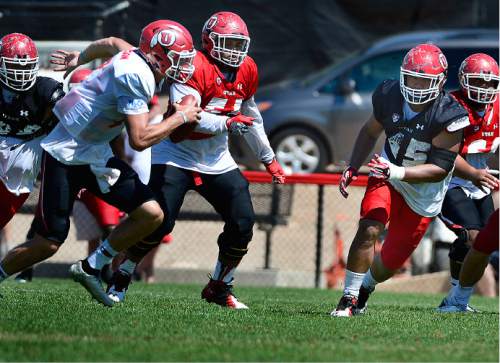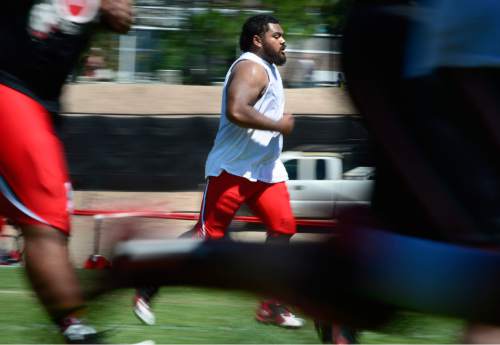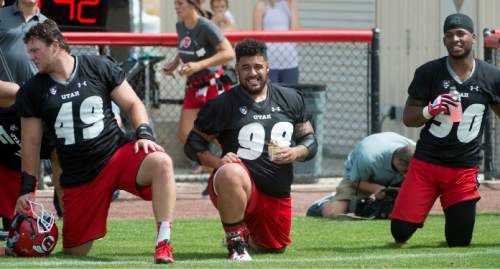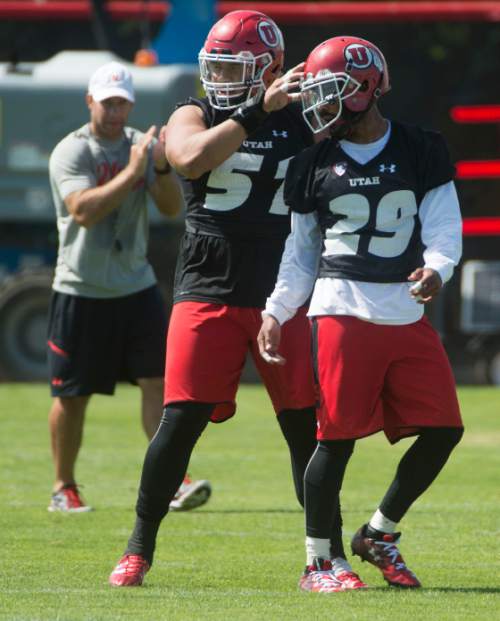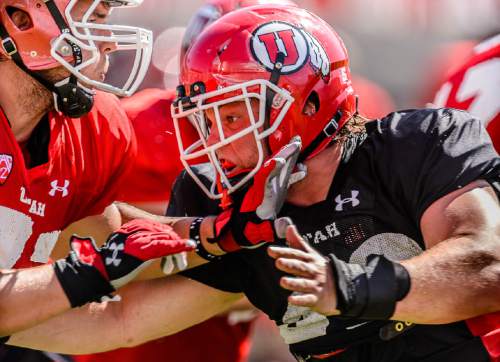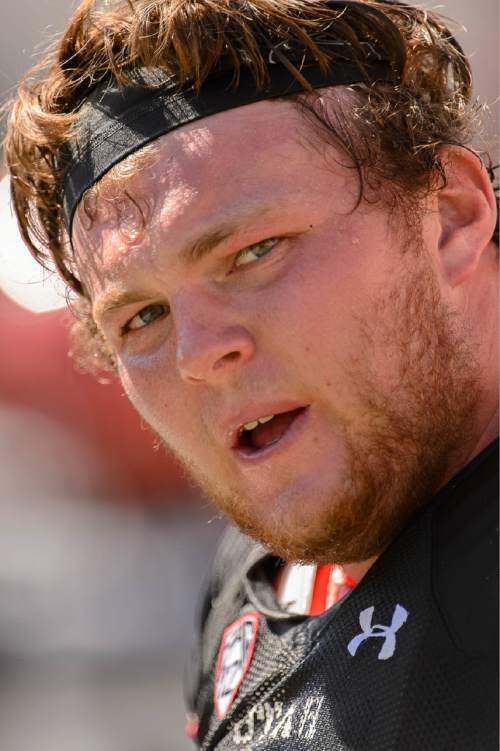This is an archived article that was published on sltrib.com in 2015, and information in the article may be outdated. It is provided only for personal research purposes and may not be reprinted.
Utah's 55 sacks in 2014 are the second-highest FBS total since the NCAA began keeping track in 2005, trailing only the 57 Stanford recorded in 14 games in 2012.
In just 13 games last season, 13 Utes dragged a quarterback to the turf, led by 18.5 takedowns from senior Nate Orchard.
"Sack Lake City" became a thing.
But here's where it gets weird: That was only the third-highest total in school history.
Possibly the best pass-rushing team in recent memory, the 2014 Utes finished four sacks shy of the 1991 Utes and 22 — yes, 22 — behind the 1981 Utes.
If Orchard was the mayor of Sack Lake City, those Utes are its founders.
It should be said that the 1981 total has doubters. The NFL didn't award sacks to individual players until the 1982 season, and Kyle Whittingham wonders if sack scorekeeping was very scientific then. NCAA statistician Jeff Williams guessed last fall that Utah credited a full sack to players involved in the same tackle, and then counted those sacks twice in adding to 77.
That's not so, said 1981 defensive end Jeff Reyes: "The first guy there got the sack. There was no double-dipping."
But even if half-sacks had counted twice in 2014, the Utes would have wound up with 61.
Seventy-seven "may be unattainable," admitted Whittingham, whose Cougars foiled the '81 Utes' hopes of ending a 17-year bowl drought. "That's, what, over seven sacks a game?"
Seven on the nose. Over 13 games, you'd need six per game to break the record. In fact, that's almost certainly unattainable, but don't tell senior defensive end Jason Fanaika.
"I think we can get it," he said. "I really do. I think it's possible for us."
Does it really matter? Said defensive coordinator John Pease: "If we get six sacks and win all our games, I'll be the happiest camper in the world."
After all, nobody will measure Utah's success this year in sacks alone.
But there may be some common threads between this defense and the 1981 bunch that defied logic in the pass-happy Western Athletic Conference.
Depth, for starters.
The 1982 media guide accounts for all 77 sacks in 1981: Defensive tackle Steve Clark, named a first-team All-American by the Football Writers Association, led the team with 12. Defensive end Mark Anderson had nine, fellow end Bob Leggins had eight, and tackle Jordan Stone had seven. Reyes and linebacker Bill Gompf had five apiece, linebacker Dan Stewart had four, and seven players had three.
"We were fresh," Reyes said. "One guy came out and another guy would come in and do just as good a job."
Nowadays, Utah relies less on blitzes to create pressure. Forty of last year's 55 sacks came while Utah rushed four or less. But the population of Sack Lake City is almost as high now as it was then.
"Our two-deep is ridiculous," said junior defensive end Kylie Fitts (who, like Leggins, transferred after playing at UCLA).
Asked where Utah will find the production that it loses in Orchard, Fanaika grew excited.
"Everywhere."
Junior Hunter Dimick is improved, Fanaika said, and so is he. Add in Fitts, a tailback until his junior year of high school who might be the most athletic player in Utah's front seven, as well as more opportunities for junior pass-rush specialist Pita Taumoepenu, and opposing tackles have their hands full.
Utah may be deeper yet at defensive tackle, where senior Viliseni Fauonuku, juniors Stevie Tu'ikolovatu and Filipo Mokofisi and sophomore Lowell Lotulelei will rotate every few plays.
That makes for an unfair fight with the every-down offensive linemen, admits Mokofisi, whose legendary dad was still a senior at East High in 1981.
"When [Seni] comes off, he's like, 'Yeah, I got him, I got him scared.' He'll tell me what he's done already and set him up for my moves."
Rounding out the front seven, Utah fields three senior linebackers in Jared Norris, Gionni Paul and Jason Whittingham who it expects to be all-conference contenders. So if you can spot a weakness, there are some Pac-12 coaches who would pay good money for that information.
Such depth allows Utah to play with its hallmark persistence.
In 1981, linebacker Jay Fairman said it was bad business to be out of frame when defensive coordinator Tom Gadd and line coach David Kotulski reviewed the tape. All 11 players flew to the ball, Fairman said, or they did up-downs and sit-ups.
"We were just a bunch of crazy banshees."
Pease — who might've helped recruit some of those 1981 Utes as the U.'s linebackers coach in 1977 — stresses the same approach.
He, linebackers coach Justin Ena and student assistant Sione Pouha seem to be popular replacements for predecessors Kalani Sitake and Ilaisa Tuiaki. And just as in 1981, when nobody wanted to let down Anderson and Gompf (who, like Reyes, later played in the USFL with Whittingham), Utah's defensive front is now held accountable by Dimick, Norris and Fauonuku.
Echoing Pease, the no-nonsense Dimick would rather discuss wins than sack totals.
"We didn't really plan on leading the nation in sacks last year," he said. "We just worked hard and thought good results would come of it, and that's what we're going to do this year."
That brings us to 1982, with a defense that noseguard Brian Martinek remembers as being more highly regarded than the 1981 bunch.
When Utah finished with just 32 total sacks.
Mokofisi, like Fanaika, doesn't think there's much danger of a falloff.
Seventy-seven, though? Seriously?
"I think we can accomplish that," Mokofisi said, smiling. "I think we already have 77 in camp."
Twitter: @matthew_piper —
"Sack Lake City" Council: The front four
Senior defensive end Jason Fanaika • Totaled five sacks last season despite playing linebacker in six games. Led team in summer with 495-pound bench press and would like to drop 15 pounds to play at 270, but the trick is staying out of the gym, he said.
Junior defensive end Hunter Dimick • Nicknamed "Snacks," by Kyle Whittingham, the 6-foot-3, 270-pounder punished teams for focusing too much on Nate Orchard, recording 10 sacks from the opposite end.
Junior Pita Taumoepenu • Former Timpview player is still raw, but "if you give him a chance just to go, he'll go 100 mph and get the job done," Fanaika said. Totaled 5.5 sacks in limited time last season.
Junior Kylie Fitts • UCLA transfer stands 6-foot-4, 268 pounds but moves like a smaller man. Fanaika believes he can play any position in the box. "He's an animal."
Senior defensive tackle Viliseni Fauonuku • Senior is the smallest of the tackles at 5-foot-11, 285, but has sacks in each of the last three seasons and is a powerful bull-rusher. He can play both left and right tackle positions.
Junior Stevie Tu'ikolovatu • At 24, the group's elder statesmen, Tu'ikolovatu is also one of the team's strongest players and is tough to move at 320 pounds.
Sophomore Filipo Mokofisi • Now at an ideal weight of 285, Mokofisi has excellent hands and technique and brings more of a finesse approach to beating offensive linemen.
Sophomore Lowell Lotulelei • Younger brother of Carolina Panthers defensive tackle Star, Lowell had four sacks as a freshman last year and similarly occupies two blockers on most downs. A big season could put him on the radar of NFL scouts. (He sat out a year after high school, making him draft eligible in 2016.)






